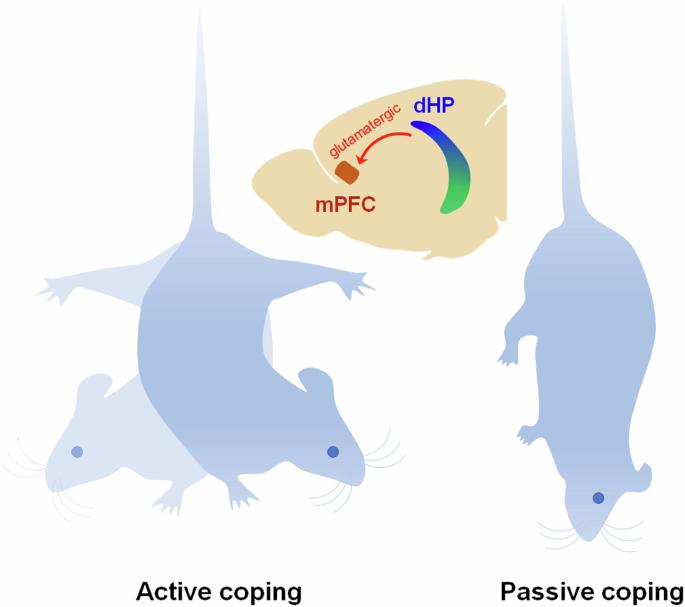背侧海马-前脑皮层回路的活动可调节无法逃避的压力时的压力应对策略。
IF 9.5
2区 医学
Q1 BIOCHEMISTRY & MOLECULAR BIOLOGY
引用次数: 0
摘要
解剖连接和病损缺失研究表明,海马背侧和腹侧分别对认知和情绪过程做出了贡献。然而,背侧海马(dHP)在情绪或压力相关行为中的作用仍不清楚。在这里,我们发现背侧海马的神经元活动会通过向内侧前额叶皮层(mPFC)的兴奋性投射影响小鼠的压力应对行为。抗抑郁药氯胺酮能迅速诱导海马背侧和腹侧的c-Fos表达。dHP抑制GABA能传导所引起的分子变化与氯胺酮诱导的变化相似,包括真核细胞延伸因子2(eEF2)去磷酸化、脑源性神经营养因子(BDNF)升高和细胞外信号调节激酶(ERK)磷酸化。dHP的这些突触和分子变化可缩短小鼠在尾悬吊和强迫游泳试验中的不动时间,但不会影响与焦虑相关的行为。相反,药理学和化学遗传学增强了dHP CA1区域的抑制性神经传递,诱导了小鼠在测试中的被动应对行为。跨神经元追踪和电生理学发现,dHP CA1神经元与mPFC神经元之间存在单突触兴奋性连接。对自由行为小鼠的dHP CA1神经元进行光遗传学刺激,可在mPFC神经元中产生c-Fos诱导和尖峰点燃。对接受dHP的mPFC神经元进行化学激活,可逆转抑制dHP CA1神经元活动所诱导的被动应对行为。总之,这些结果表明,dHP的神经元活动可调节对无法逃避的压力的应对策略,并通过dHP-mPFC回路促进氯胺酮的抗抑郁作用。本文章由计算机程序翻译,如有差异,请以英文原文为准。


Activity in the dorsal hippocampus-mPFC circuit modulates stress-coping strategies during inescapable stress
Anatomical connectivity and lesion-deficit studies have shown that the dorsal and ventral hippocampi contribute to cognitive and emotional processes, respectively. However, the role of the dorsal hippocampus (dHP) in emotional or stress-related behaviors remains unclear. Here, we showed that neuronal activity in the dHP affects stress-coping behaviors in mice via excitatory projections to the medial prefrontal cortex (mPFC). The antidepressant ketamine rapidly induced c-Fos expression in both the dorsal and ventral hippocampi. The suppression of GABAergic transmission in the dHP-induced molecular changes similar to those induced by ketamine administration, including eukaryotic elongation factor 2 (eEF2) dephosphorylation, brain-derived neurotrophic factor (BDNF) elevation, and extracellular signal-regulated kinase (ERK) phosphorylation. These synaptic and molecular changes in the dHP induced a reduction in the immobility time of the mice in the tail-suspension and forced swim tests without affecting anxiety-related behavior. Conversely, pharmacological and chemogenetic potentiation of inhibitory neurotransmission in the dHP CA1 region induced passive coping behaviors during the tests. Transneuronal tracing and electrophysiology revealed monosynaptic excitatory connections between dHP CA1 neurons and mPFC neurons. Optogenetic stimulation of dHP CA1 neurons in freely behaving mice produced c-Fos induction and spike firing in the mPFC neurons. Chemogenetic activation of the dHP-recipient mPFC neurons reversed the passive coping behaviors induced by suppression of dHP CA1 neuronal activity. Collectively, these results indicate that neuronal activity in the dHP modulates stress-coping strategies to inescapable stress and contributes to the antidepressant effects of ketamine via the dHP-mPFC circuit. Understanding our brain’s handling of emotions and thought is vital. Recent research indicates that different sections of the hippocampus are responsible for either thought processing or emotional reactions. However, new research by Yoon et al. disputes this, demonstrating that both hippocampus sections can affect behavior via connections with the prefrontal cortex, a brain area involved in decision-making. This study, a mouse experiment, examined how a specific pathway between the dorsal hippocampus and the medial prefrontal cortex impacts behavior, especially in response to stress and depression-like symptoms. The researchers used various methods, including gene alteration and behavioral tests, to understand how changes in this pathway’s activity affect behavior. This study paves the way for future research to explore how these brain areas interact in the context of emotional and thought processing, potentially leading to more effective depression treatments. This summary was initially drafted using artificial intelligence, then revised and fact-checked by the author.
求助全文
通过发布文献求助,成功后即可免费获取论文全文。
去求助
来源期刊

Experimental and Molecular Medicine
医学-生化与分子生物学
CiteScore
19.50
自引率
0.80%
发文量
166
审稿时长
3 months
期刊介绍:
Experimental & Molecular Medicine (EMM) stands as Korea's pioneering biochemistry journal, established in 1964 and rejuvenated in 1996 as an Open Access, fully peer-reviewed international journal. Dedicated to advancing translational research and showcasing recent breakthroughs in the biomedical realm, EMM invites submissions encompassing genetic, molecular, and cellular studies of human physiology and diseases. Emphasizing the correlation between experimental and translational research and enhanced clinical benefits, the journal actively encourages contributions employing specific molecular tools. Welcoming studies that bridge basic discoveries with clinical relevance, alongside articles demonstrating clear in vivo significance and novelty, Experimental & Molecular Medicine proudly serves as an open-access, online-only repository of cutting-edge medical research.
 求助内容:
求助内容: 应助结果提醒方式:
应助结果提醒方式:


